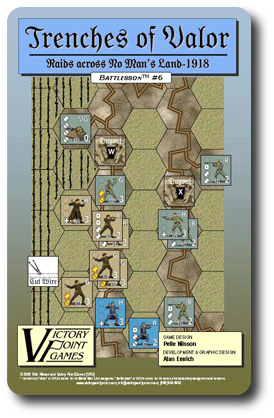
The Basics:
- For ages 7 and up (publisher suggests 10+)
- For 1 or 2 players
- About 25 minutes to complete
Geek Skills:
- Counting & Math
- Logical & Critical Decision Making
- Strategy & Tactics
Learning Curve:
- Child – Moderate
- Adult – Easy
Theme & Narrative:
- Test your logical and critical decision making skills as you strategize how best to either raid a trench line or hold the line during World War I!
Endorsements:
- Gamer Geek approved!
- Parent Geek mixed!
- Child Geek approved!
Overview
The world was at war in 1915. Young men left their homes to fight in foreign lands with names they could not pronounce, but knew all too well once the fighting began. Massive armies clashed with victories and losses on both sides. There were also heroes and leaders who overcame seemingly insurmountable obstacles at every turn. One such obstacle was the deadlock between miles of trenches where soldiers on both sides hunkered down. The area between the trenches was known as “No Man’s Land” and it was the most dangerous place on Earth. Miles of explosives, berms, barbed wire, deadly gas, and bullets met any foolish enough to try to cross it. But cross it they must if they were to win the war, and both sides knew it. A full assault was beyond foolish, but small groups of soldiers sent in during the cover of night, crawling on their bellies through the mud, just might be able to cross the line and poke a hole in the enemy’s defenses. It was risky, but worth it if it meant the stalemate would end.
Trenches of Valor: Raids Across No Man’s Land (1915-1918), by Victory Point Games and part of their Battlesson series, is comprised of 1 fold out map that depicts the trenches of World War I and 42 game pieces that depict the soldiers and specific markers used in the game. Also included in the bag is a small six-sided die that is meant to be used in the game, but we suggest you use a regular sized six-sided (we kept losing ours). The game is part of an introductory wargame series, and as such, the rules are few so as to not crush new players, but none of the game play or tactics have been watered down.
Game Set Up
Trenches of Valor is a scenario based game where the same map is always used, but depending on the scenario, different pieces are placed on it. These different pieces represent soldiers representing Germany, Great Britain and Canada, and France. World War I is rich with historic battles and the scenarios are meant to capture very specific skirmishes in the Great War (as it was known until World War II started). This makes game set up simple, fast, and the focus of the game play specific to the victory condition set by the scenario.
Regardless of the scenario selected (there are 6 in total), a game will always be set up by first unfolding the map and placing it in the middle of the playing area. This map represents a typical World War I trench line and its surrounding area. It is further divided into hexes to help the players judge distance and move the game pieces. Included on the map are necessary tables that summarize the player’s turn and the terrain.
After the map is placed, a scenario must be selected. As stated, there are 6 scenarios provided in the game. Each scenario will list the game pieces for the Defending player (the one in the trenches) and the Raiding player (the one who is attacking the trenches). Included in the scenario is the starting position for all the game pieces, how many game turns available until the game automatically ends, specific scoring, and any special rules. As an added bonus, historical notes are provided for each scenario to provide the players the details of the conflict.
Once the scenario is set up, the game is ready to start!
Take Up Our Quarrel With the Foe*
As this is a wargame, it stands to reason the game is about combat. Specifically, the game is about short skirmishes. The game only provides so many rounds (one round being the completion of both player’s turns). Once the round is over, points are counted. The points scored reward the player for completing specific requirements as noted in the scenario.
A single turn is played out as follows:
- Raiding player takes one action with all their game pieces
- Defending player takes one action with all their game pieces
- Game turn maker is decreased by one
- Next round beings or end of game
On a player’s turn, they can choose to take a specific action with their current game pieces on the map. Each game piece the player owns can only take one action and then it can no longer be used for the duration of the turn. For veteran wargamers, this might seem very limiting, but for new players not familiar with wargames, this simplifies the game and brings it to a level that can be easily taught. Simple in its execution, but not a walk in the park. The actions provided, because they are limited in number, force the player to carefully consider each move. A wasted or miscalculated action will cost the player a game piece, or possibly, the game.
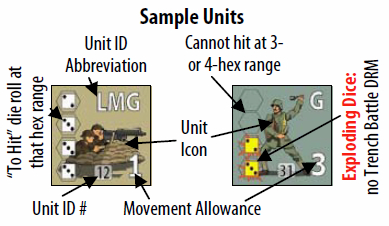
The three actions available to the player for each of their game pieces is as follows:
Move
Movement on the map is done using hexagons and movement allowance. Depending on the what terrain is represented in that hexagon, it might cost the player more movement points. The movement action does not end until the player has used up all the movement points, cannot pay the movement cost to continue, or simply chooses to no longer move their game piece.
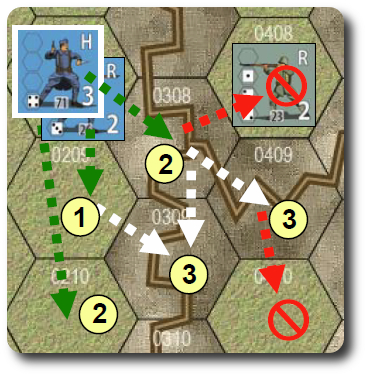
Example of movement
Open terrain and trenches will only cost 1 movement point, but only if the unit remains in the trenches or out in the field. If the unit jumps out of or into a trench, it will cost 2 movement points.Wire hexes can only be crossed if the unit has the “Cut Wire” marker. All the movement information is on the map making it quick and easy to look up if a player should forget.
Game pieces can move off the game map, moving across “No Man’s Land” to the safety of their own trenches. However, by doing so, that particular game piece is no longer available in the game. Depending on the scenario, a player might be awarded points for successfully retreating their soldiers.
Attack
To attack another game piece, the player rolls the six-sided die and attempts to roll a value that is equal to or less than the value noted for that particular game pieces range. The further away the target, the harder it is to hit and not all units represented by the game pieces have the same range or effectiveness in combat. For example, a unit that only has hand-to-hand melee weaponry (entrenching tools and the like) can only hit another game piece if it is 1 space away but will hit more times than not, while a machinegun unit can hit another game piece up to four spaces away but with an increased level of difficulty of doing so the further the target is. This simple mechanism will ensure that player will have to maneuver their game pieces in such a way so they can obtain maximum efficiency and at the same time reduce their losses.
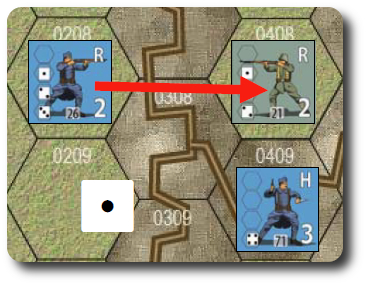
Attack example: The player needs a roll of "2" or less to hit at a range of 2 - player rolls a "1' and the attack is successful!
If a player successfully hits, the targeted game piece is removed from the map. Again we see the simplified game rules that are meant to facilitate fast and easy to learn game play. The only other rule of note in regards to attack is the target’s location. If the target is in a trench or a dugout, it can be harder to hit. This is represented by inflicting a penalty to the attacking player’s die roll. In this way, it is possible for a player to further defend their units.
Clear Dugout
This is a special action only available to the player who is the Raider and does two things. First, the cleared dugout is counted as victory points for the raiding player at the end of the game. Second, any units in the dugout are also removed from the game! This action is successful by default (no die roll required), but is risky as the unit must end its movement on the same terrain space as the dugout and cannot clear it until their next turn.
Of Hide and Seek
Trenches of Valor is a game of timing and tactics. A player has limited actions and must think about their moves keeping the end goal in mind at all times while reacting to the ever-changing battle field. One of the options a player might have available to them is hiding their true strength from the other player. A player can “hide” a unit (which is technically not in play until revealed) and setting up “decoys” to confuse the other player. Hidden units cannot attack or move and must reveal themselves to take an action, but the act of revealing the unit takes up their action for that turn. Any decoy unit that is placed on top of them is removed when the real unit is placed.
Victory!
As the game progresses, the game turns remaining in the scenario will decrease. At a certain point int he game, the Raider can attempt to exit their units if things are going particularly bad, earning some points in the processes. Once the final turns ends, the game is concluded.
Victory is awarded to the player with the most points. Raiding players always score 1 victory point for every successfully exited unit plus any victory points noted on the scenario. If the Raider scores points higher than or equal to the victory condition noted in the scenario, they win. If not, the defending player wins the game and there are never any ties. This is an interesting twist on the victory condition as it means the Defender is doing their best to outlast and hamper the Raider at all costs. The Raider is doing all they can to hit hard, hit fast, and then quickly retreat with as few casualties as possible.
Solo Play?
Trenches of Valor can be played as a solitaire game. The scenarios are still used as are the same rules, but the game play is slower and rather confusing when it comes to timing. The rules are not specific enough to make it easy to understand what to do when going solo. As such, we cannot recommend this game as a solitaire experience as it simply confused us more than anything else.
To learn more about Trenches of Valor: Raids Across No Man’s Land (1915-1918), see the game’s official web site and download the full rules. It might also interest you to know that the game is expanded with Trenches of Valor Expansion Kit 1: Raids across No Man’s Land (1917 to 1918) that adds 6 more scenarios, a new map, and three more units.
Prediction
I have often debated with others the morality of wargames. Some argue that a game about war trivializes the cost of life and destruction that war brings. Others argue that it’s just a game. I am in the middle of these two camps, both as a parent and as a military veteran.
For me, a wargame challenges a player to think long-term strategy while at the same time adjusting their tactics to stay on track with their short-term goals. In this way, Chess is very much like a wargame, but much more abstract. Miniature games are also wargames, if you want to be really general about it. In fact, any game that pits one pieces against another could somewhat reflects an aspect of a wargame. This makes Checkers a wargame, too.
Not, not really…that’s a bit of a stretch, isn’t it?
But when a Chess piece is removed from the board, a mech in BattleTech is destroyed, or a dragon is slain by a hero, is this a violent act? Possibly. It all depends on how one views it. For me, I view it as a game where game pieces are moved and removed from the board. There is no personal loss, and with no personal loss, there is nothing I morally object to (as long as my opponent didn’t cheat). Wargames that depict their playing pieces as people in a real situation, however, start to cross lines that makes some uncomfortable. Again, however, I do not morally object. It is still a game piece and nothing more.
Now, from a parenting perspective, I am not looking to use a wargame as a platform to pontificate my personal opinions about war to my children or friends. Instead I use the wargame to challenge my little geeks and myself to stop and really focus on what needs to be done with limited and ever-changing options. It is hard to win a wargame if a player is not going into it with a healthy attitude about risk and reward. In short, the player must be willing to risk to push for victory and take hits along the way. This is why, in my opinion, wargames are often seen as aggressive. They are designed for the player to take offensive and defensive behavior that, even in the abstract, is easy to understand as “attacking” or “blocking”.
For my oldest little geek, a wargame is nothing he could have handled early on in his young geek career. First off, he didn’t have the geek skills to pull it off. Even when you are playing a very concrete wargame, you must think in the abstract. This is not something that comes naturally to many of us. Second, he didn’t have the emotional coping skills to distance himself on a personal level whenever a game piece was removed from the game. Wargames are something you work into, but is a very worthwhile goal to achieve.
After years of game playing, my little geek was ready for a game like Trenches of Valor. It plays fast, makes you think, and will punish you if you start to slack off. From a Gamer Geek perspective, I already love it, but the Parent Geek in me is not yet feeling warm and fuzzy about it. From a Child Geek perspective, this game might just be right for them.
Explaining the game didn’t take long, which is not to suggest the game is easy. The game mechanisms are easy and intuitive, even for those who have not played wargames before. Recognizable elements are used and reused in the game, and different situations use the same core rules to make every new possibility familiar and simple to comprehend. At least, my 7-year-old had no problem grasping the concept of the game or how it was played. His questions were only about specific movement, distance to target, and the difference between a Raider and a Defender. After answering his questions, he felt very confident he could play the game and knew exactly what side he wanted to play.
We selected the first scenario to play only because it was the first in the list. There is nothing to suggest in the rules that one scenario is harder than the others. As we set up the game, I asked my little geek what he thought of it so far.
“Looks pretty easy to play. I think being able to jump into trenches is a neat idea.” ~ Liam (age 7)
He is correct. For a skirmish wargame with very little in the way of bulky rules, the game provides fora lot of manuevers. Let’s give this game a play or two and see if it can survive.
Final Word
Wargames are traditionally complicated. This is necessary as the rules must balance luck with player skill. The only way to do this fairly is to make the rules account for every situation. The consequences of this is lots and lots of rules, especially when you play the insanely detailed wargames like Advanced Squad Leader which literally has thousands of pages of rules. Clearly, not for the squeamish. That’s why skirmish wargames that use a core set of rules and only add to them as the situation requires based on the scenarios are so popular. Trenches of Valor does the same thing but appears to be specifically intended to introduce wargames to players rather than attempting to be a hardcore game. If this is the case, it has certainly succeeded.
My little geek loved the game and hated it. Ultimately, his geek love won out and was only being buffeted by his young geek rage of not being able to corner his father in a trench. This was not the fault of the game, but rather his choices when it was his turn. He struggled at first, but got into the groove and eventually played very well. We played the same scenario twice (switching sides) and he did much better, not because of his new role in the game but because of his understanding of the game rules. In his own words, he said the game was “challenging and rewarding without feeling like school work.” That pretty much summed it up for him and he was hooked. He loved the game and what it was about, which was part of the real joy of it. After playing the game, we looked up World War I on our computer and learned more about it because he wanted to know what it was all about.
Parent Geeks were a mixed bag on this one. The Parent Geeks who played lots of games enjoyed it very much, remarking on how “smart” the game played using very little rules. The Parent Geeks who played lighter games did not care for it, not because of the rules, but because of the game’s objective and theme. They just didn’t care for wargames. They made sure to tell me it wasn’t because Trenches of Valor was a “bad game”, it just wasn’t their cup of tea.
Gamer Geeks? They were hard to pin down at first. Everyone enjoyed the game a great deal and all agreed it was light but did very well for what it was. Then they got specific and started hating on the game quality. This is understandable as the game is nothing more than paper and cardboard. As far as game durability goes, Victory Point Games is not at the top of the pile, but nor are they trying to be. Their rules and games are solid and they keep their prices down by focusing on game play and experience rather than spending all their money on components. This is clearly reflected in their game prices. For some Gamer Geeks, this was a mark against the game, but for most, it hardly mattered.
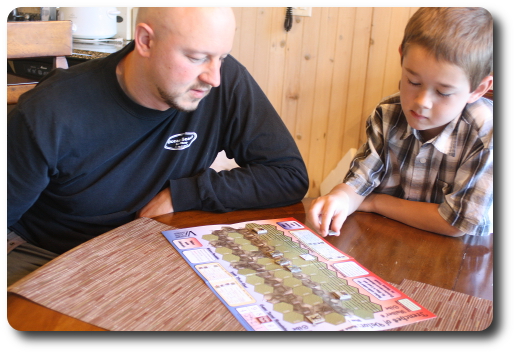
My little geek moves his unit into position to clear a dugout, while I think about my next move
Gamer Geeks, Trenches of Valor is worth your time. It plays fast, has a streamlined rule set, and gives the player a great deal of flexibility to play the game using their own strategy and tactics. It’s small-scale is overshadowed by the way the game plays which makes it feel larger than what it is. You’ll find yourself carefully studying the board to find the optimal path through the trenches to a target, carefully maneuvering your units to overtake an opponent, and constantly reevaluating the situation. The game play will keep you on your toes and will satisfy. Excellent for pregame warm up, finishing up an evening of games, or just looking for a meaningful 2-player game experience. The solo game is not nearly as entertaining as the 2-player game, which is how it really should be played.
Parent Geeks, your level of enjoyment of this game will be based on your game preferences. If you enjoy a 2-player game where you are constantly maneuvering and victory is based on skill and foresight, then Trenches of Valor is going to be greatly enjoyed. If you don’t, well, I am pleased to report there any many other games available for you to play. However, if you are already a wargame lover and have little geeks who are interested in this game genre, Trenches of Valor will serve you well. It introduces the majority of the wargame concepts without being restrictive or heavy. The rules are just right for quick play skirmishes and create an excellent base for more advanced wargames.
Child Geeks, if you have always wanted to play at the table, move miniatures, and feel the thrill of close calls and narrow victories, Trenches of Valor is the first place you need to look. The game has simple rules to learn but these only help facilitate the game itself. You have to do all the thinking and have all the control when it comes to doing what you want in the game. For this reason, you might also feel the game is a bit one-sided at times, especially if playing against a skilled opponent. Your units are only going to do what you tell them, which means if you don’t have a lot of experience, it will show. But this is expected and making mistakes is encouraged as you learn from every misstep and success. The game plays fast and you’ll be setting up your next scenario knowing more than you did the last game. In no time, you’ll be making your opponent work for their victory!
I was very pleasantly surprised with Trenches of Valor and Victory Point Games is quickly moving up my ladder of game publishers I greatly enjoy. This game is everything I want it to be. It’s small enough to take anywhere, plays big enough to satisfy my gaming needs, challenges me, is easy to teach, easy to learn, and has unlimited replay value. All of this for under $20! You don’t find wargames that provide this much for so little money down. I can see myself playing this game just about anywhere and with just about anyone. It has also hooked my oldest little geek and has him thinking of playing more complex games and has him interested in history. If that’s not a total win, I don’t know what is.
In the mood for a very affordable, fun to play, and easy to teach skirmish wargame? If so, do put your crosshairs on Trenches of Valor: Raids Across No Man’s Land (1915-1918)!
This game was given to Father Geek as a review copy. Father Geek was not paid, bribed, wined, dined, or threatened in vain hopes of influencing this review. Such is the statuesque and legendary integrity of Father Geek.




VPG deserves your admiration.
At this time, I couldn’t agree more. They have yet to disappoint.
I first have to say that I am very impressed you got Liam to play a “real” wargame. The closest I can get to a wargame with my 8 year-old son is Memoir ’44 (also a fun game, and it provides some background for each scenario). For him, if there aren’t minis, he’s not interested.
Regarding component quality, it is very easy to rip on the components of the game when comparing it to titles from Fantasy Flight or Days of Wonder. But the money for these type of games is spent on the historical accuracy and research and so it is more like buying a history book. Wargames typically come with supplemental material that give the reader historical context, something which I greatly appreciate and enjoy (I am much more interested in history now than I was back in high-school). A better comparison of the component quality would be against something published by GMT, Multi-Man Publishing or Lock N Load Games. Paper and light cardboard maps are standard for these types of games, but GMT and LNL are leading the curve here with mounted maps like are typically seen in Euro and Ameritrash games. Overall, if the graphic design of the counters, map and cards(if applicable) make the game easy to play as well as attractive, I’m satisfied.
A suggestion to the readers here is if there is an interest in this game, another light wargame I recommend is “Storm Over Stallingrad”. Simple rules, easy to read counters along with card and dice play make it another good game to try out. The added bonus is to become more aware of the various battles that took place in WWII.
But I do believe this is a game that I would enjoy. GMT has gone as far to republish an upgraded version of Victory Point Games “No Retreat! The Russian Front” which I have on order and anxiously await its arrival. Thanks for the review Cyrus 🙂
Pingback: The Drive on Metz Game Review » Father Geek